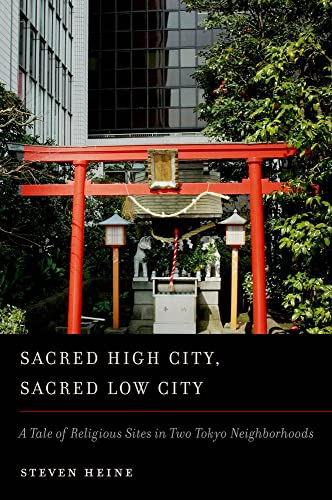Sacred High City, Sacred Low City: A Tale of Religious Sites in Two Tokyo Neighborhoods - Hardcover

"synopsis" may belong to another edition of this title.
Steven Heine, Professor and Director of Asian Studies at Florida International University, is an authority on Japanese religion and society, especially the history of Zen Buddhism and its relation to society in China and Japan. He has published over twenty books and dozens of articles, and has lectured extensively on these and related topics.
"These nuanced refinements to broadly accepted scholarship are without doubt a courageous and important contribution to the field of Japanese religions....This book is undoubtedly an important contribution to scholarship on Japanese religiosity, and will provide food for thought for both researchers and students of Japanese studies, but it will also appeal to the general public."
--Japan Review
"[T]he contributions of Sacred High City, Sacred Low City cannot be overstated. Taking a significant step in moving Western scholarship beyond the gaze upon the Japanese other, Heine has offered a shift in paradigm that will change the direction of this field for years to come. Undergraduate and graduate courses on Japanese cultural and religious studies or on the confluence of contemporary religious practice and material consumption would be well served by adding this text to required reading." --Philosophy East and West
"Interesting... a fruitful reexamination of the conventional wisdom of what religion is and does in contemporary Japan." --Religious Studies Review
"Highly engaging and accessible... this is a significant contribution the the study of contemporary Japanese religiosity--particularly, but not exclusivley, urban religiosity...Sacred High City is a must-read for anyone with an interest in Japanese religions, sociology of religion, ritual spaces, or religion and modernization." --Journal of Ecumenical Studies
"Heine questions the notion of 'born Shinto...die Buddhist,' a widely accepted understanding of Japanese religiosity. He proposes a new notion, 'Born Shinto...live Inari...die Buddhist,' adding that 'the use of the phrase 'live Inari,' refers to customs or practices habitually carried out within a worldview of myth and magic found in both Buddhist and Shinto contexts.'"--Religion Watch
"This is necessary reading for those interested in Japanese religiosity in particular and in the Japanese worldview in general." --CHOICE
"Steven Heine offers a provocative paradigm for understanding Japanese religion, one adding to the 'Born Shinto, Die Buddhist' dichotomy by foregrounding the crucial 'Live Inari' dimension. Heine also suggests that the 'benefits' so often cited as impetus for religious practice are sometimes of an 'impractical yet this -worldly' (genze hi-ryaku) variety, meeting Japanese needs for consolation, refuge, and respect for historical memory. A must-read for students of Tokyo religiosity."-- John Tucker, Professor of History and University Historian, East Carolina University
"Through his exploration of sacred spaces in two Tokyo neighborhoods, Heine offers a nuanced critique of dominant notions about Japanese religious life. Paying careful attention to institutional structures and religious motivations in specific contexts, he opens up new perspectives on the complex religious landscape of Japan. Anyone interested in Buddhism, Shinto, ritual, and tradition will benefit from this groundbreaking book."-- Christopher Ives, author of Imperial-Way Zen
"Heine's clear prose and engaging style reveals the historic and contemporary richness of Tokyo's most renowned--as well as often overlooked--ritual spaces. For anyone interested in the continued relevance and survival of religious institutions in today's global, post-modern and hyper-urbanized world, this is a must-read."-- Pamela D. Winfield, Department of Religious Studies, Elon University; Founding co-chair, Sacred Space in Asia Group, American Academy of Religion
"About this title" may belong to another edition of this title.
- PublisherOxford University Press
- Publication date2011
- ISBN 10 0195386205
- ISBN 13 9780195386202
- BindingHardcover
- Edition number1
- Number of pages240
- Rating
Buy New
Learn more about this copy
Shipping:
US$ 37.00
From Japan to U.S.A.
Top Search Results from the AbeBooks Marketplace
Sacred High City, Sacred Low City : A Tale of Religious Sites in Two Tokyo Neighborhoods : ()
Book Description Condition: Brand New. In Sacred High City, Sacred Low City, Steven Heine argues that lived religion in Japan functions as an integral part of daily life; any apparent lack of interest masks a fundamental commitment to participating regularly in diverse, though diffused, religious practices. The book uses case studies of religious sites at two representative but contrasting Tokyo neighborhoods as a basis for reflecting on this apparently contradictory quality. In what ways does Japan continue to carry on and adapt tradition, and to what extent has modern secular society lost touch with the traditional elements of religion? Or does Japanese religiosity reflect another, possibly postmodern, alternative beyond the dichotomy of sacred and secular, in which religious differences as well as a seeming indifference to religion are encompassed as part of a contemporary lifestyle?. Seller Inventory # a29203

